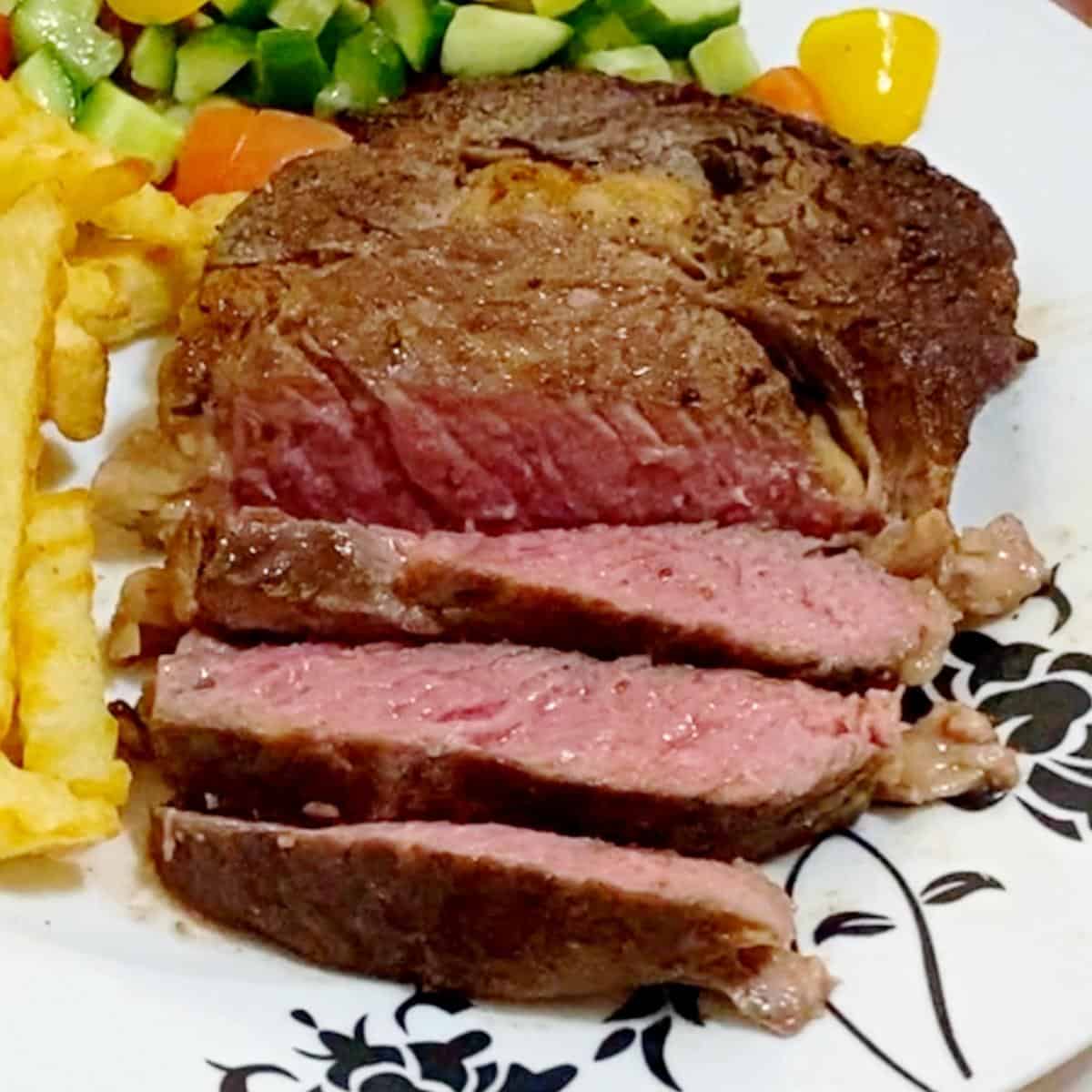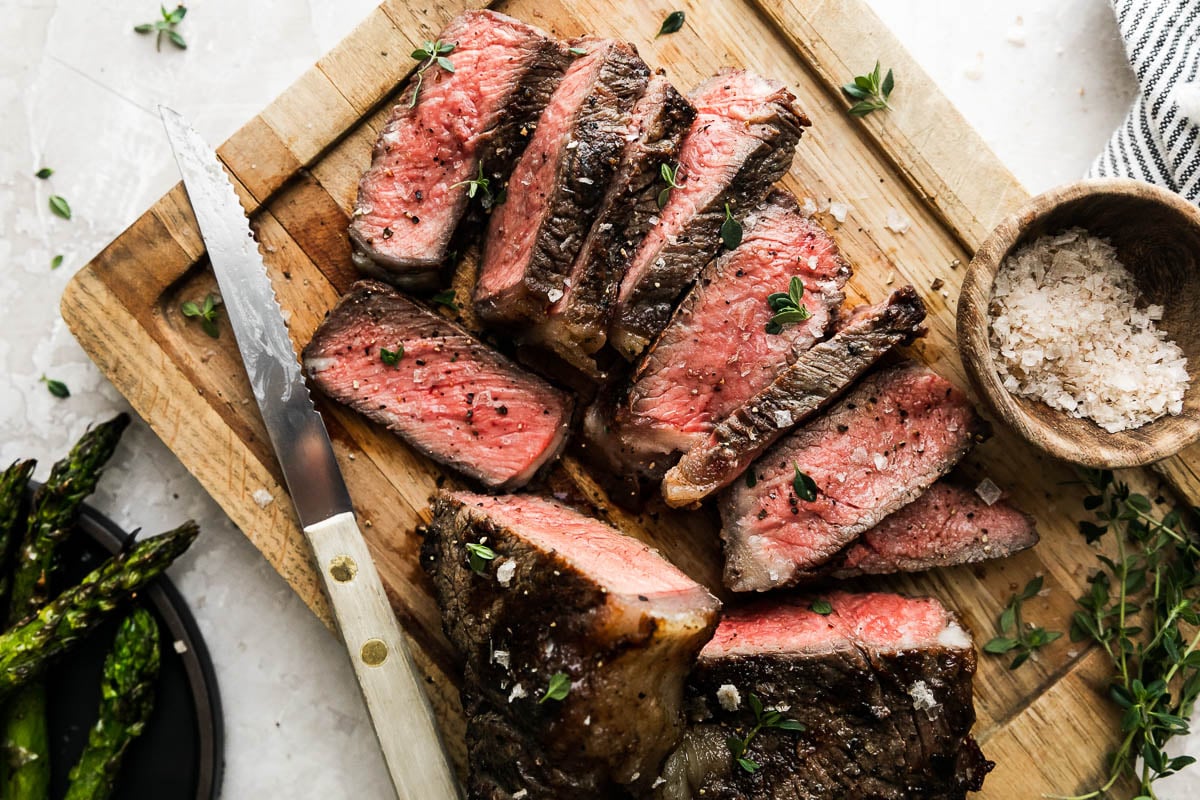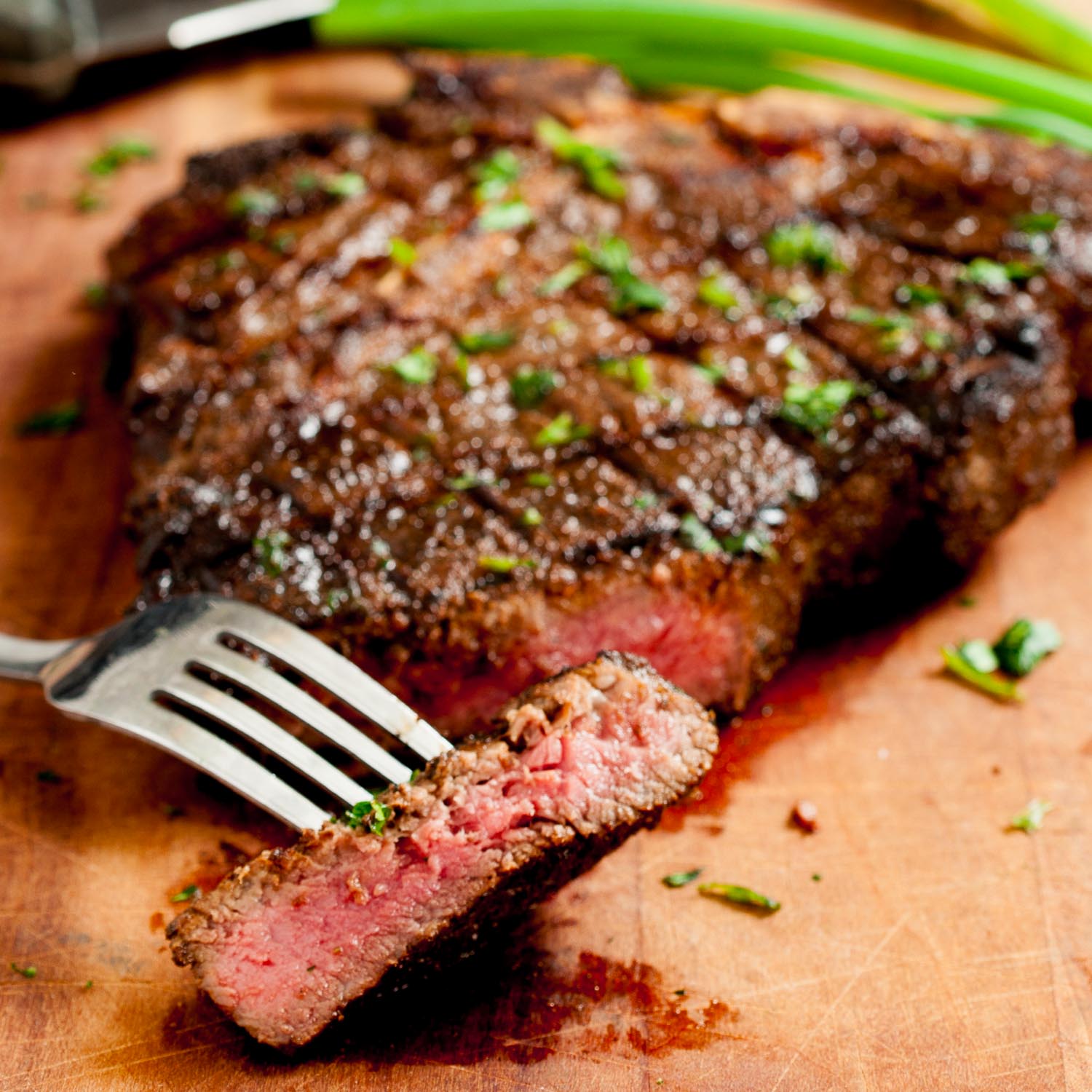The Ultimate Guide to Cooking a Perfect Steak at Home

:strip\_icc()/101201681-caf3126916884b93824a294662c14ca5.jpg)
Choosing the Right Steak
Factors to consider when selecting a steak
When it comes to cooking the perfect steak, choosing the right cut of meat is crucial. Here are some factors to consider when selecting a steak:
-
Marbling: Look for steaks with consistent marbling, which are thin streaks of fat throughout the meat. This marbling adds flavor and tenderness to the steak.
-
Thickness: The thickness of the steak will affect the cooking time and temperature. Thicker steaks require longer cooking times to reach the desired doneness.
-
Grade: Steaks are graded based on their quality and tenderness. The highest grade is prime, followed by choice and select. Prime steaks are usually the most tender and flavorful.
Popular steak cuts and their characteristics
There are various cuts of steak available, each with its own unique characteristics. Here are some popular steak cuts to consider:
-
Ribeye: Known for its rich marbling, the ribeye is flavorful and tender. It is best cooked using high-heat methods like grilling or broiling.
-
Sirloin: The sirloin is a versatile cut that offers a balance of tenderness and flavor. It can be cooked using different methods, including grilling, pan-searing, or roasting.
-
Fillet Mignon: This is one of the most tender cuts of steak and is known for its buttery texture. It is often cooked using dry-heat methods like pan-searing or grilling.
Remember, the quality of the steak and the cooking technique used will greatly influence the final result. Choose the right steak based on your preferences and follow the recommended cooking instructions for the best outcome. Enjoy your perfectly cooked steak!

Preparing the Steak
Properly thawing and seasoning the steak
To cook the perfect steak, it's crucial to start with a properly thawed and seasoned piece of meat. Here's how you can do it:
-
Thawing: If your steak is frozen, ensure that you thaw it completely before cooking. The best way to do this is by transferring it from the freezer to the refrigerator and allowing it to thaw slowly overnight. This method ensures even thawing and helps retain the steak's moisture.
-
Seasoning: Seasoning your steak with the right spices adds flavor and enhances its taste. A simple seasoning of salt and pepper can do wonders for the steak. Apply the seasoning evenly on both sides, ensuring thorough coverage.
Marinating vs. dry rubs
The choice between marinating and using dry rubs depends on personal preference and the flavor profile you want to achieve. Here's the difference:
-
Marinating: Marinating involves soaking the steak in a mixture of herbs, spices, and liquids such as vinegar or soy sauce. This method adds flavor and tenderizes the meat. For best results, marinate the steak for at least 30 minutes to allow the flavors to penetrate the meat.
-
Dry rubs: Dry rubs are a mixture of spices that are rubbed onto the surface of the steak. They create a flavorful crust when grilled or seared. Dry rubs are perfect for those who prefer a slightly stronger and more intense flavor.
Remember to allow the steak to come to room temperature before cooking, as this ensures even cooking. Now you're ready to grill or sear your steak to perfection!

Cooking Techniques
Grilling: Tips for achieving the perfect char
To cook the perfect steak on the grill, follow these tips:
-
Preheat the grill: Make sure your grill is hot before you start cooking. This helps to sear the steak, sealing in the juices.
-
Season the steak: Rub the steak with your favorite seasoning or marinade, allowing the flavors to penetrate the meat. Let it sit at room temperature for about 30 minutes before grilling.
-
Control the heat: Use a two-zone heat method by placing the coals on one side of the grill. This allows you to sear the steak over high heat and then move it to the cooler side to finish cooking.
-
Time your cook: Use a meat thermometer to monitor the temperature. For medium-rare, cook the steak until it reaches 130-135°F (55-57°C), then remove it from the grill and let it rest for a few minutes before slicing.
Pan-searing: Achieving a delicious crust
To achieve a delicious crust when pan-searing steak, follow these steps:
-
Choose the right pan: Use a heavy-bottomed skillet or cast-iron pan that can retain heat evenly.
-
Preheat the pan: Heat the pan over medium-high heat until it's hot. Add oil or butter to the pan and let it melt and heat up.
-
Season the steak: Season the steak with salt and pepper or your preferred seasonings.
-
Sear the steak: Place the steak in the hot pan and cook for a few minutes on each side, until a crust forms. Reduce the heat to medium and continue cooking until the desired doneness is achieved.
Oven-roasting: Cooking steak to tender perfection
To cook steak to tender perfection in the oven, follow these steps:
-
Preheat the oven: Set your oven to a high temperature, around 450°F (230°C).
-
Season the steak: Season the steak with salt, pepper, and any other desired seasonings.
-
Sear the steak: Heat a skillet over medium-high heat and sear the steak on both sides until a crust forms.
-
Transfer to the oven: Place the seared steak on a baking sheet or in an oven-safe pan and transfer it to the preheated oven. Cook until the desired internal temperature is reached. Use a meat thermometer to check for doneness.
Remember to let the steak rest for a few minutes before serving to allow the juices to redistribute and make every bite juicy and delicious.

Determining Doneness
Using a meat thermometer for accurate results
Cooking the perfect steak starts with determining the level of doneness you desire. One of the most accurate ways to do this is by using a meat thermometer.
Here's how to use a meat thermometer for accurate results:
-
Insert the meat thermometer into the thickest part of the steak, avoiding any bones or fat.
-
Make sure the thermometer is not touching the pan or the cooking surface, as this can give you an inaccurate reading.
-
Wait for the thermometer to give you a reading. For a rare steak, the temperature should be around 125°F (52°C). For medium-rare, it should be around 135°F (57°C). For medium, it should be around 145°F (63°C). And for well-done, it should be around 160°F (71°C).
Visual cues to determine the level of doneness
If you don't have a meat thermometer, you can also determine the doneness of your steak using visual cues:
-
Rare: The center of the steak will be bright red and the meat will feel very soft when pressed.
-
Medium-rare: The center will be pink and the steak will feel slightly firm when pressed.
-
Medium: The center will be light pink and the meat will feel firm when pressed.
-
Well-done: The center will be gray or brown and the meat will feel very firm when pressed.
Remember to let the steak rest for a few minutes before cutting into it to allow the juices to redistribute. This will ensure a deliciously juicy and flavorful steak every time.

Resting and Serving
Why resting the steak is crucial
Congratulations! You've successfully cooked a mouthwatering steak to perfection. But wait, before you dig in, it's important to let the steak rest. Resting allows the juices to redistribute within the meat, ensuring a juicy and tender steak that is bursting with flavor. Resting also helps to retain the moisture, preventing it from spilling out onto the plate when you cut into it.
To rest the steak, simply remove it from the heat source and let it sit for about 5 to 10 minutes. This resting period is essential for larger cuts of meat, as it allows the internal temperature to even out and the meat fibers to relax.
Slicing and serving the steak
Now that your steak has rested, it's time to slice and serve it. Here's a guide to help you do it like a pro:
-
Start by placing the steak on a cutting board and find the direction of the meat fibers. This will determine how you should cut the steak.
-
Use a sharp knife and make clean, even slices against the grain of the meat. Cutting against the grain helps to break down the muscle fibers, resulting in a more tender and easier-to-chew steak.
-
Serve the slices on a warm plate or platter. You can garnish the steak with some fresh herbs or a drizzle of sauce to enhance the flavors.
Remember, the perfect steak is a labor of love, and these final steps of resting, slicing, and serving are crucial for an exceptional dining experience. So take your time, enjoy the process, and savor every delicious bite of your perfectly cooked steak.

Enhancing the Flavor
Serving suggestions and popular steak accompaniments
For a perfectly cooked steak, you need to consider the sides and accompaniments that will enhance its flavor and create a well-rounded meal. Here are some serving suggestions that pair well with a juicy steak:
-
Classic steakhouse sides: Serve your steak with traditional sides like mashed potatoes, creamed spinach, or a crisp Caesar salad. These classic accompaniments provide a balanced and satisfying meal.
-
Roasted vegetables: Pair your steak with a medley of roasted vegetables, such as carrots, Brussels sprouts, and asparagus. The caramelized flavors of the vegetables complement the rich taste of the steak.
-
Sautéed mushrooms: Cook some mushrooms in butter and garlic for a delicious and earthy topping. The umami flavors of the mushrooms will add depth to your steak.
Sauces and marinades to elevate the taste
To take your steak to the next level, consider using sauces and marinades that will add flavor and moisture. Here are some options to consider:
-
Peppercorn sauce: A classic choice for steak lovers, this creamy sauce combines cracked peppercorns, butter, and cream to create a luxurious taste that pairs perfectly with a juicy steak.
-
Red wine marinade: Marinate your steak in a combination of red wine, garlic, herbs, and spices to infuse it with rich flavors. This marinade adds depth and tenderness to your steak.
-
Chimichurri sauce: This Argentinean sauce made from fresh herbs, garlic, and olive oil is a vibrant and tangy complement to your steak. It adds a burst of flavor and freshness.
Remember to let your steak rest for a few minutes after cooking to allow the juices to redistribute and ensure a juicy and tender bite. With the right accompaniments and sauces, you can elevate the taste of your steak and create a memorable dining experience.

Troubleshooting and FAQs
Common mistakes to avoid when cooking steak
When it comes to cooking the perfect steak, there are a few common mistakes that can easily ruin your meal. Here are some things to avoid:
- Not letting the steak come to room temperature: Taking the steak straight from the fridge and throwing it on a hot pan can result in unevenly cooked meat. Let it sit at room temperature for about 30 minutes before cooking to ensure even cooking.
- Overcooking the steak: This is a major no-no if you want a juicy and tender steak. Overcooking can leave the meat dry and tough. Use a meat thermometer to determine the desired level of doneness.
- Not resting the steak: Resting the cooked steak allows the juices to redistribute throughout the meat, resulting in a more flavorful and tender steak. Let it rest for at least 5 minutes before cutting into it.
FAQs about cooking the perfect steak
Here are some frequently asked questions about cooking the perfect steak:
- Which cut of steak is best for grilling? Cuts like ribeye, strip loin, and tenderloin are best for grilling as they have good marbling and are tender.
- How long should I cook a steak for medium-rare? The cooking time will vary depending on the thickness of the steak, but a general guideline is around 4-5 minutes per side for a 1-inch thick steak.
- What is the best way to season a steak? A simple seasoning of salt, pepper, and garlic powder can go a long way. You can also experiment with herbs and spices to add more flavor.
- How do I know when my steak is done? Using a meat thermometer is the most accurate way to determine the doneness of your steak. For medium-rare, the internal temperature should be around 135°F (57°C).
- Should I marinate my steak? Marinating can add flavor and tenderness to the steak. However, it's not necessary if you choose a good quality cut of meat.

Conclusion
Congratulations! Now you have all the knowledge and tips you need to cook the perfect steak. It may take some practice to master the techniques, but with time, you'll be able to cook mouthwatering steaks like a pro. Remember to choose high-quality cuts, season them well, and use the right cooking method based on your preferred level of doneness.
Summing up the guide to cooking the perfect steak
- Start with choosing the right steak cut. Opt for prime cuts such as ribeye, New York strip, or tenderloin for superior taste and tenderness.
- Season the steak generously with salt and pepper, or your preferred seasoning blend, at least 40 minutes before cooking. This allows the flavors to penetrate the meat.
- Preheat your grill or skillet to high heat. Searing the steak at high heat creates a delicious crust and locks in the juices.
- Cook the steak to your desired level of doneness using a meat thermometer to ensure accuracy. Remember that the internal temperature will continue to rise after removing the steak from heat.
- Let the steak rest for a few minutes before slicing. This allows the juices to redistribute, resulting in a juicy and flavorful steak.
Final tips and recommendations for steak enthusiasts
- Experiment with different seasonings and marinades to add variety to your steaks.
- Consider trying different cooking methods, such as sous vide or reverse searing, to achieve different textures and flavors.
- Invest in a good-quality meat thermometer for accuracy.
- Don't forget to let your steak rest before serving to maximize flavor and juiciness.
- Pair your perfectly cooked steak with delicious sides, sauces, and a glass of your favorite wine for a complete dining experience.



